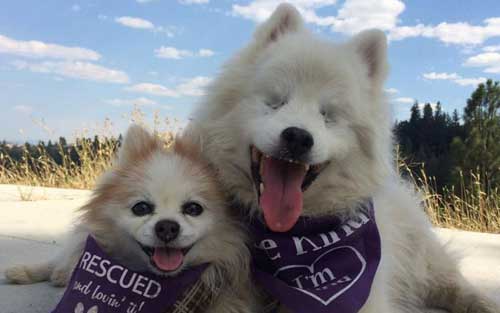
The local shelters are bursting at the seams with adoptable dogs this time of year. Some may be older or have special needs and have years of unconditional love to give. Learn about how it might be easier than you think to provide a little extra TLC to a special needs dog.
Training A Special Needs Dog
By: Jeff Dentler, CPDT-KA, CTDI
Training our dogs is all about communication. Clear, consistent cues enable our dogs to learn quickly and easily, while reinforcing the learned behaviors make the behaviors strong and long lasting. But how can we communicate to our furry, four-legged friends if they can’t see or hear us? In reality, training a blind or deaf dog is no different than you would train a dog that can see or hear. It’s as easy as ABC.
Antecedent. Behavior. Consequence.
An antecedent is something that causes a behavior to occur. A classic example is the ringing of the doorbell causing a dog to bark. When training, an antecedent can be a food lure, physical prompt, verbal cue, or hand signal that causes the dog to sit, down, come, or whatever behavior we are trying to train. The consequence is what happens after the behavior is performed. A positive consequence (reinforcement) will cause the behavior to increase, while a negative consequence (punishment) will cause the behavior to decrease.
Every behavior is always preceded by an antecedent and followed by a consequence. Some of those antecedents and consequences occur naturally in the environment, but when we control the antecedents and consequences we control behavior. The only difference between a blind/deaf dog and one that can see/hear may be how the antecedent and consequence is applied.
Training a deaf dog.
Dogs don’t understand English, or any other spoken language for that matter. How they learn is by associating a certain behavior, through repetition, with a sound that comes out of our mouths. However, dogs are masters at reading body language – that’s how they communicate with each other – so I find that training a deaf dog is rather easy using hand signals. Think of it as a form of dog sign language. The biggest challenge for training a deaf dog is getting his attention from a distance, and a vibration collar is a great way to let your dog know you want him to look at you. Once you have his attention you can use your hand signals to communicate to him. (Please note that a shock collar should never be used on any dog. And although some shock collars do have a vibration setting, I do not recommend using one this way, as they have been known to malfunction and can shock dogs at random times.)
Training a blind dog.
As stated above, a dog’s first line of communication is reading body language, so training a blind dog is more challenging. However, we can still use their other senses, especially a dog’s superior sense of smell, to teach them.
Lure-reward training, coupled with clicker training, is a highly effective way to teach your dog new behaviors. This type of training simply involves using food to guide your dog into the desired position or behavior. You then click, or mark, to let your dog know he did the correct thing, then reinforce the behavior with the food. Through repetition and consistent cueing your blind dog can easily learn just about anything you want to teach him.
Training a deaf and blind dog.
A dog that is both deaf and blind presents a more complicated training challenge, as the antecedent – the thing that makes behavior happen – cannot be a hand signal or verbal cue. So how do we ask our dogs to do what we want? We use touch. A gentle touch to a particular place on their body can be their cue to perform a certain behavior. For example, if you are training your deaf/blind dog to sit you would touch your dog on her rear at the base of her tail, lure her into a sit, then reinforce the behavior with food. With the consistent steps of cue-lure-reinforce your dog will learn behaviors in no time.
Final thoughts.
Dogs are born deaf and blind, and don’t gain their hearing and eyesight until about two weeks after birth. So dogs that are deaf or blind from birth seem to handle it quite well – it’s all they’ve ever known! On the other hand, dogs that had their hearing or sight then lost it have more problems adjusting to their disability, and more care and patience needs to be taken.
Special needs dogs can, and do, thrive, but particular care must still be taken to ensure their safety. They may not be able to see or hear cars, predators, or other dangers. Use a secure, physical fence in your yard, and never leave them outside without direct supervision. Use crates and baby gates in your home to keep them from stairs or dangerous objects in your home.
Deaf and blind dogs are no different than other dogs. They just hear and see with their hearts. As their caretakers it is our responsibility to accept them as they are and treat them with the love and respect that they, and all animals, deserve.
Resources to help your special needs dog:
Deaf Dog Education Action Fund
Deaf Dogs Rock
Blind Dog Training
BlindDogs.net
Karen Pryor Clicker Training
Jeff Dentler, a Certified Professional Dog Trainer (CPDT-KA) and Certified Trick Dog Instructor (CTDI), provides dog training and behavior modification to residents of the greater Pottstown, PA area. Contact Jeff at jeff@DentlersDogTraining.com or 610-505-0123. For more information and daily tips on training, exercise, health, and nutrition please visit DentlersDogTraining or like us on Facebook.



